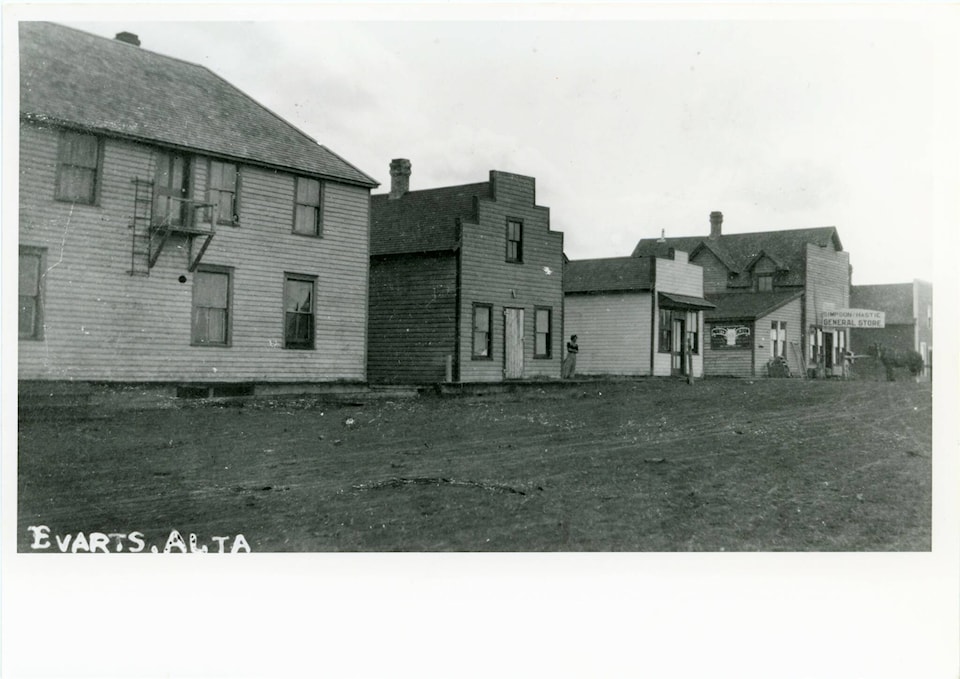The history of Red Deer has often followed boom and bust cycles. In the good times, growth and prosperity seem almost limitless. In the bad times, sometimes it seems that the economic downturn will never end. Fortunately, in general, growth and prosperity eventually return.
However, there are places in Central Alberta, which once enjoyed a sense of heady optimism, but are now largely forgotten. They were boom towns that went bust and never recovered.
One of these places is the Red Deer Crossing, the original community in this area. It was situated at one of the best all-weather fords across the Red Deer River. As such, it was a natural magnet for the early travelers and settlers in Central Alberta.
Over time, freighters and settlers built shacks at the Crossing. In 1882, Bob McClellan and his family built a small house and started a small farm. Later, he built a stopping house or hotel at the fledgling settlement.
Over the next few years, two stores and another small stopping house were built at the Crossing. A big change came in 1884, during the Riel Rebellion, when the Canadian military commandeered McClellan’s hotel, fortified it, and created Fort Normandeau. The Rebellion was soon over, but Fort Normandeau was converted into a police post for the North West Mounted Police.
Another big change for the community also came in 1884, when Sage Bannerman started a ferry across the river and built another stopping house on the north side. Using the Crossing as a transportation and trading hub became even more attractive.
The big blow to the settlement came in 1890, when the Calgary-Edmonton Railway was built. Instead of building the new rail line through the Crossing settlement, the C. &. E. Railroad Company struck a deal with Leonard Gaetz to create a new townsite on his farm, a few kilometres to the east. Everyone wanted to be next to the railroad because of the greater ease of transportation that it offered.
The Crossing settlement was soon abandoned as its residents moved to new homes in the new hamlet of Red Deer. The stockade of Fort Normandeau was chopped up for firewood and a portion of the main building was hauled away and converted into a farmhouse.
Another community in Central Alberta which boomed and then went bust when it got by-passed by the railroad was Content. Situated on the Red Deer River, north of current day Delburne, Content was started by Albert A. Content, an entrepreneur and lumberman, who saw possibilities of creating a transportation and supply centre for the homesteaders moving into East Central Alberta.
Content was just a short distance west of a much earlier community, Tail Creek, which had been the home to large numbers of buffalo hunters in the 1870’s. At one time, Tail Creek was the one of the largest communities west of Winnipeg. It disappeared shortly after the once plentiful herds of buffalo vanished.
By 1909, Content boasted two or three stores, a lumberyard, hotel, school, doctor’s office and a creamery. The community suffered a set back with a bad fire, but a more permanent set back came when the new Grand Trunk Pacific Railway decided to bypass Content. New townsites of Delburne and Ardley were created along the rail line and Content was soon no more.
In 1902, a settlement named Evarts, named in honour of Luther Evarts, developed at a ford across the Medicine River. It quickly became a thriving transportation and distribution centre for homesteaders who were looking for new homes in the West Country. By 1906, Evarts had several stores, a hotel, restaurant, church, school, barber shop, pool hall, and a creamery. Evarts was growing so rapidly that it was incorporated as a village.
In 1910, both the Alberta Central and Canadian Northern Western Railways by-passed Evarts and new townsites were created at Benalto and at Eckville. Not all the buildings in Evarts were abandoned and there still remains a beautiful but tiny hamlet next to the bridge across the Medicine River. However, it never became the “Metropolis on the Medicine” that the early pioneers had once imagined.
Michael Dawe is a Red Deer historian and his column appears on Wednesdays.
